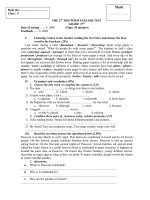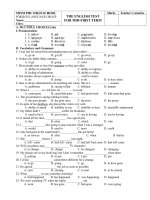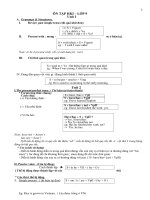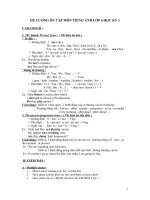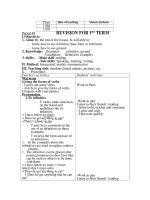Report for mid term project video superman in your area
Bạn đang xem bản rút gọn của tài liệu. Xem và tải ngay bản đầy đủ của tài liệu tại đây (388.68 KB, 28 trang )
REPORT FOR MID-TERM PROJECT
VIDEO:
_Superman in your area_
Submitted by: Group 7
Course: Soft skill Development
Class: PPHE101.5
Instructor: Mr. Hoang Anh Duy
& Mrs. Dau Thu Huong
Hanoi, April 2020
Table of Contents
2
I. ACKNOWLEDGEMENT
Firstly, we are all grateful that we were able to complete our Mid-term Video project
within the time given by our lecturers in this Skills Development Class. This work had
been done with all the hard-working, efforts and dedication from eight members of our
group. All of us have tried our best to contribute to the accomplishment of this project
and we actually have a great time to co-operate as a team.
In addition, in performing our assignment, we had to take the help and guideline of
some respected persons, who deserve our greatest gratitude. The completion of this
project gives us much pleasure. We would like to show our gratitude to Mr. Hoang
Anh Duy and Mrs. Dau Thu Huong, our respectful course instructors, for giving us a
good guideline for the project through lots of helpful lessons and advice.
As last, we would also like to give our big thanks to our friends and respondents for
their assistance and willingness to give valuable feedback, which helps us a lot to build
up and complete this project.
3
II. ABSTRACT
It is a heroic story, not like most normal stories telling about heroes and their enemies,
where heroes are considered perfect as usual. In our story, a little different, the heroes
have been put into a tough situation. From that, they have not only to complete their
mission but they also learn how to understand mutually and make themselves better.
The story centers on a team of four called "Superman Squad", which includes the
superman with their own duty, character and some weaknesses as well. They are
named after the color Red, Blue, Yellow and White. Red is the leader and he is an
absolutely earnest person. The second one is Blue whose responsibilities are
researching, inventing and innovating equipment. Opposite of Red, he is quite calm
and quiet but not good at communication. The next guy is Yellow. His characters are
vivacious and optimistic. He is also the member having the most times of coming late
because of oversleeping. The last guy is White and he is in charge of the doctor of this
team. It might be due to the feature of work he is so patient and meticulous. And he is
an emotional guy. All of the members have superpower and special abilities in
different fields, they know and discover each other's abilities then form a group like a
family. They are the “heroes” of the new era. Whenever they receive an emergency
signal "The danger is approaching" they will gather and destroy that danger together,
bringing peace and safety for the world. On other days, they are just ordinary people,
doing extremely normal jobs like everyone else: researchers, doctors, office workers,
company managers.
One day, Red was ordered to summon urgently because they discovered a bad guy and
his army invaded. He suddenly left all the unfinished work and ran to the headquarter
constantly to gather their team. However, when he arrived, Blue and White had been
there to prepare, but Yellow was absent. After waiting for a while, they found out the
dangerous signal and left to fight without Yellow. The villains' motherships invaded
rapidly, starting the vigorous devastation to the cities. Three Supermen immediately
appeared and there was an excruciating battle happening between two sides.
Unfortunately, their enemy was too strong and they struggled due to lacking in people.
Blue was seriously injured and although they tried their best to fight with the enemy,
they had to be lost at the first battle.
Coming back to headquarters, at that time Yellow was rushing to, nobody paid any
attention to him. This failure made the “Super Squad” team’s mood extremely bad,
silence covered everyone. Then, Red stared at Yellow angrily, which made him feel
terribly sorry. Suffocating this atmosphere was. But soon they all know that the best
thing they can do right now is to lift their spirits up and discuss the next plans for their
following battle. Therefore, they sat down and talked about the reason for losing. They
4
found out that some problems existed on their team. Those are the bad timemanagement skill of Yellow, the bad communication skill of Blue and the most
important one: Teamwork skill. Eventually, the Leader could make all understand that:
“We are a team, not individuals”. Yellow and Blue also realized their own weakness
and promised to improve with the other’s support. They immediately started a period
of soft-skills training in a special course. They kept themselves to learn hard and
trained hard. The result was a phenomenon. Yellow improved his time management
and Blue became so much more open to every member. Still, the villains returned and
brought threats to Earth’s peace. Nevertheless, Superman Squad had become more
close-knit and stronger than ever. They have struck together, fought together and
worked perfectly with each other. Finally, they defeated the bad and continued to
ensure peace to everybody on the planet. After all, not only did they win their enemies
but they also defeated themselves. They got over their own obstacles and limits
together.
From the stories, we study a worthy lesson when working as a team. Don’t mind if you
have a weakness, get over all together and win yourself. Let's be the better version of
ourselves.
5
III.
INTRODUCTION
1. Rationale of study
All we could not deny that soft skills are an important part of finding, attracting,
and retaining clients. For instance, presentation skills, networking abilities can help
you win new clients and gain more work from existing clients. Developing your
abilities to resolve conflicts, solve problems, and provide excellent customer service
can lead to close relationships with colleagues, customers, and other professional
contacts. Finally, advancing soft skills as much as possible will help you gain
confidence and have more chances in the business world.
On the other hand, a lack of soft skills can limit your potential, or even be the downfall
of your business. By developing strong leadership, teamwork, and communication
abilities, you can run projects more smoothly on your own.
Last but not least, it is necessary for students to meet skill and academic needs of the
students through the provision of viable training options for vocational skill
development. The students must develop and adopt skills required by the workforce.
Student’s awareness of the relevance and nature of soft skills requirements directly
impacts employability.
2. Purpose
Today, numerous business and economic universities in Vietnam have popped up like
mushrooms in every nook and corner of the country. As a result, the intake of students
is rising year by year, it is of utmost importance to realize which type of skills sets are
being inculcated in these students to be easily succeed in the future career. The
objective of this project is to find out the influence of soft skills on the university
students along with the hard skills to catch their goals.
In particular, the purpose of this report concentrates on highlighting the importance of
three soft skills: Time-management skill, Communication skill and Teamwork skill.
From that, it encourages people, in particular, university students to change to be a
better version of themselves.
3. Method of study
First of all, we read the material and information from the Skill course of Mr. Hoang
Anh Duy. This course really helps us broaden our knowledge in the field of important
soft skills. We also read some articles and researches in this field. For our project, we
chose 3 skills that we considered the most essential. After discussing, we chose the
method of doing our own video that took the inspiration from Superman to convey our
ideas and help the viewers realize the importance of those soft skills by an easy
approach.
6
4. Scope of study
This report focuses on three soft skills when we work as a team/group: Timemanagement skill, Communication skill and Teamwork skill.
7
IV. LITERATURE REVIEW
1. Overview of three skills
1.1.1.
Time-management Skill
This skill is a fundamental skill that students need to succeed at the university level.
Time management is defined as how one schedules or manages the time to get
academic and personal goals. Good time-management skills involve planning the
following things: work priorities, listing short-term and long-term goals, and
appropriate allocation of resources to meet those goals. On the other hand, poor timemanagement skills commonly result in a lack of completed goals, increased stress, and
a high tendency towards procrastination.
1.1.2.
Communication Skill
Almost everyone has difficulties with communication at different levels. Conveying
your opinions, ideas, needs and feelings in an academic and professional way must be
definitely challenging. This experience might make you nervous or even be frightened.
Mastering the basic soft skills can make a big difference in your career path.
The essential Skills modules provide comprehensive instruction in four critical
interpersonal communication skills: planning your message, active listening,
expressing yourself clearly, and receiving and responding to feedback. Using real-life
examples drawn from the reports of graduate students in science and engineering, you
will enhance your ability to communicate effectively for academic, personal, and
professional success.
1.1.3.
Teamwork Skill
Teamwork skills are essential to your success at work. No matter your industry or job
title. Working well with clients, colleagues, managers and other people in your
workplace can help complete tasks efficiently while creating an enjoyable environment
both for yourself and others. An organization that emphasizes on good teamwork skills
is typically a healthy, high-functioning workplace.
2. Theories on Time-management Skill
There are a number of theories which have been developed in relation to timemanagement. In this report, we just mention some popular theories.
2.1.
The Bucket of Rocks Theory
To be able to manage time, people need to understand the level of importance and
urgence that each task holds. The Bucket of Rocks theory (also referred to as the
Pickle Jar Theory) offers insight into the order in which a person should work on his
activities (Mancini 2003).
8
The theory proposes that you put big rocks in a bucket (this will represent the
important things) and then you fill it up with pebbles followed by sand and then water.
The smaller substances represent increasingly unimportant tasks (Forsyth 2010).
According to this theory, we are supposed to do the important things (big stones) first
and then move on to the less important things (pebbles and sand). Finally, if we have
excessive time, we can do the unimportant things (water). We must acknowledge that
if we begin working on the unimportant things or the less important things first, we
will not have the space to do the important things in our lives.
2.2.
ABC System
In life, everyone is on average faced with several works which require time and
attention. In many circumstances, the available time we have might not be sufficient
for all the work that needs to be done.
Then, in order to use time more effectively, it is necessary for a person to prioritize the
tasks. The ABC system developed by Alan Lakein can provide an efficient means for
prioritizing. Mancini (2003) demonstrates that using the ABC approach can facilitate
an individual’s prioritizing.
The letter assigned to a given task denotes its priority level with A being the tasks with
highest urgency, B the tasks that have low urgency but are of importance and C being
tasks that are not urgent and whose completion can be postponed. Mancini (2003)
states that the tasks can be broken down further as A1, A2, A3, etc with A1 being the
most urgent and important task.
From the ABC list, one can ask themselves questions such as “I’m putting off an A
priority because it is unpleasant?” or “Will I manage to achieve the C priority tasks
before they become A’s?” Such questions will result in insights being gained into how
to accomplish the most important and critical tasks first.
9
2.3.
The Inventory System
When we are responsible for some duties, we learn from them and are in a position to
do them better orderly. The inventory system is a results-oriented approach that is
based on the premise that one learns the most by reviewing how they handled the day
and applying these lessons to the next day’s behavior (Forsyth 2010).
This theory argues that a retrospective analysis of activities done represents a more
behavior changing approach to dealing with situations in life. Mancini (2003, p.162)
declares that “behavior modification is a significant time management strategy”. As
such, while the inventory system is not in itself a time-saving measure, it results in the
establishment of time-saving behavioral changes in a person.
2.4.
Time Management Grid
This theory involves placing the activities that need our attention on a grid. The grid
then reveals how each activity is being categorized based on how soon it needs to be
done (Harris 2008). The grid consists of 4 quadrants and each quadrant has a different
priority level.
The first grid which is quadrant one has tasks that have the highest importance and
bear urgency and therefore should be done immediately. The second grid has important
activities that are not as urgent. Harris (2008, p.22) refers to the activities in this
quadrant as “quality time” which means that while the activities are of importance to
the success of a company, they do not require to be done immediately.
10
The third grid consists of activities that bear urgency but are of no importance. This
grid is therefore also known as the distraction grid since the activities contained
therein do not bear much importance to helping one achieve goals. Finally, the forth
grid contains activities that are neither urgent nor important.
2.5.
The other theories
Goal setting theory which involves coming up with challenging and achievable goals
is also suggested as one of the means through which time can be managed. Another
time management principle is the Time Management Windows Principles which
borrows from Johari’s window.
The Johari’s window
This principle considers that time can be wasted in a group setting if effective
communication is hindered. Pareto’s 80/20 rule which identifies that only 20% of our
activities produce 80% of the results we desire is also utilized.
11
Finally, the paper discusses Assertiveness which can assist an individual to avoid
wasting time.
These theories were tested and the results reported to maximize on study time. From
the usage of these theories, people can discover the best way to manage their time and
gain the most optimum results.
3. Theories about Communication Skill
The origins of communication theory are linked to the development of information
theory in the early 1920s. Limited information-theoretic ideas had been developed
at Bell Labs, all implicitly assuming events of equal probability.
Harry Nyquist's 1924 paper, Certain Factors Affecting Telegraph Speed, contains a
theoretical section quantifying "intelligence" and the "line speed" at which it can be
transmitted by a communication system.
Ralph Hartley's 1928 paper, Transmission of Information, uses the word "information"
as a measurable quantity, reflecting the receiver's ability to distinguish one sequence of
symbols from any other. The natural unit of information was therefore the decimal
digit, much later renamed the Hartley in his honor as a unit or scale or measure of
information.
Alan Turing in 1940 used similar ideas as part of the statistical analysis of the breaking
of the German second world war Enigma ciphers.
The main landmark event that opened the way to the development of communication
theory was the publication of an article by Claude Shannon (1916–2001) in the Bell
System Technical Journal in July and October 1948 under the title "A Mathematical
Theory of Communication". Shannon focused on the problem of how best to encode
the information that a sender wants to transmit. He also used tools in probability
12
theory, developed by Norbert Wiener. They marked the nascent stages of applied
communication theory at that time. Shannon developed information entropy as a
measure for the uncertainty in a message while essentially inventing the field of
information theory. "The fundamental problem of communication is that of
reproducing at one point either exactly or approximately a message selected at another
point.”
In 1949, in a declassified version of Shannon’s wartime work on the mathematical
theory of cryptography ("Communication Theory of Secrecy Systems"), he proved that
all theoretically unbreakable ciphers must have the same requirements as the one-time
pad. He is also credited with the introduction of sampling theory, which is concerned
with representing a continuous-time signal from a (uniform) discrete set of samples.
This theory was essential in enabling telecommunications to move from analog to
digital transmissions systems in the 1960s and later.
In 1951, Shannon made his fundamental contribution to natural language
processing and computational linguistics with his article "Prediction and Entropy of
Printed English" (1951), providing a clear quantifiable link between cultural practice
and probabilistic cognition.
4. Theory on Teamwork: Tuckman’s Teamwork Theory
Tuckman describes working with a team of social psychologists, on behalf of the U.S.
navy. The team studied small group behavior, from several perspectives. In doing so,
Tuckman reviewed 50 articles on group development and noticed that there were two
features common to these small groups: the interpersonal or group structure, and the
task activity. From this he identified that groups evolved into teams via four common
stages.
Firstly, an orientation, testing phase which often led to a period characterized by a
degree of conflict. This then generally resolved itself, leading to a more socially
cohesive phase. Finally, groups settled to a functional phase, during which they
focused on role-relatedness. To summarize these four phases, Tuckman coined the oftquoted terms: “forming”, “storming”, “norming” and “performing”.
Tuckman’s teamwork theory is best illustrated on a graph which shows the link
between group relationships (the horizontal axis) and task focus (the vertical axis). The
optimal or “performing” position is reached when relationships have developed within
the group and it has started delivering with a clear focus on the task.
However, Tuckman’s ideas clearly indicate that it takes time to reach the “performing”
stage, and it’s normal for these teams to go through ups and downs as they develop
relationships. Particularly in the early period, which is perhaps why Tuckman called it
the “storming” phase!
The 4 Phases of Tuckman’s Teamwork Theory
13
14
V. RESEARCH METHODOLOGY
Inspired by this picture, our team came up with an idea for our video not only in order
to express our gratitude to medical staff but also to spread our message: It’s easy to let
negative thoughts and feelings creep in during the COVID-19 pandemic. However,
keeping a positive mindset can go a long way in managing through the difficult time.
“Holding onto that positive attitude can help you center on things that provide you
with what you need to make it through this day. It’s really important these days.”, said
The Evangelical Lutheran Good Samaritan Society senior pastor, Greg Wilcox. “But
you can’t do it alone”, he also added. So we believe that people have to be united.
Each of us is a superhero, we carry great power but with great responsibilities. Even
lacking the cooperation of an individual can destroy the effort of a whole nation. So
until everything recovers, we must act together to slow the spread of the virus and look
after each other. We are in this together – and we will get through this, together.
In addition, our country has made it. Even without the appearance of superheroes or
heroes with extraordinary power, we have the solidarity and unanimity of the entire
people, the close and precise direction from the state, and the most important thing is:
15
We have the silent sacrifices, the relentless efforts of the doctors. Those are the whiteshirt superheroes, the heroes of peacetime. The same as the story was created by our
team, that is not a fairy tale with a familiar motif like "The righteous always wins",
this is a true story written by the efforts and determination of each person. Together,
we will create a "teamwork" with unbeatable power. That is the greatest thing ever !!!
16
VI. FINDING AND ANALYSIS
1. Teamwork skills
1.1.
Definition
Teamwork is the collaborative effort of a team to achieve a common goal or to
complete a task in the most effective and efficient way. When a group of people works
together cohesively, towards a common goal, supporting each other to combine
individual strengths to enhance team performance.
1.2.
Benefits
Ideas:
A good team made of diverse members. Businesses thrive when they have a diverse
team of people who can contribute individual ideas, come up with a more effective
solution than one person working on the same problem.
Support and sense of responsibilities:
Teamwork creates a system to ensure that deadlines are met and when one member
falls behind there will be other members to help and finish the task. When work is
divided into among members, it gets done faster, making the overall business operate
more efficiently.
1.3.
Methods to develop teamwork skills
The role of leaders:
Leaders are the ones that the rest of the members look to for guidance, so they must
understand how to harness individual strengths to achieve the objectives.
Clarify purpose:
If a team doesn’t understand the purpose of their work, their attention and enthusiasm
can dwindle. Clearly articulating and repeating the team’s common goal can help the
team to maintain focus, and be motivated.
Clearly defined roles:
Everyone in a team should have crystal clear understanding of what their role and
responsibilities within the group are. This will help limit confusion or time spent
organizing and delegating work so individuals can simply focus on their task at hand.
Communication:
Good communication is at the heart of great teamwork. Great teams communicate well
and often, their members are happy to share ideas, brainstorm together, ask for
feedback, and be contradicted.
1.4.
In the video
In our video, each superman has their own unique skills, abilities and characteristics,
but also do they have their own weaknesses. Moreover, it necessitates a proper
collaboration between members in fighting against villains. Therefore, when trying to
17
save the world from the monsters, every vigilante has learned one cannot always do
everything, and missing one is also a big problems
For instance, even though with three heroes Red, Blue and White, which they have
strong will, great power and a brave heart, they still can not defeat the monster on their
own without Yellow. However, Red had shown the importance role of a leader – one of
the most essential factors in teamwork. Red has been thinking and decides to open a
conversation. Finally, he can understand the others weaknesses and characteristics,
gives them proper advice and guidance and makes them realize that when they unite
with others, they are much stronger. Working together can lead to so many positive
outcomes, from learning new skills, succeeding, self-discovery and improvement.
Besides, each member can become a better version of themselves. Thus, the power of
the team will increase which will have a magnificent outcome.
2. Communication skills
2.1.
Definition
Communication is sending and receiving information between two or more people.
Communication is the act of conveying meanings from one entity or group to another
through the use of mutually understood signs, symbols, and semiotic rules. The person
sending the message is the sender, while the person receiving the information is called
the receiver. The information conveyed can include facts, ideas, concepts, opinions,
beliefs and even emotions.
2.2.
Benefits
Building trust:
Effective communication fosters trust with others. Your ability to listen attentively and
embrace different points of view helps others trust that you are making optimal
decisions for everyone in the group.
Creates better relationships:
Good communication also improves relationships, both in workplaces with colleagues
and in your personal life with friends and family members. Listening carefully and
offering quality feedback helps people to feel heard and understood. This, in turn,
nurtures mutual respect.
Providing clarity:
With effective communication skills, you’re able to deliver clear explanations and your
message’s objectives. Communicating with clarity can prevent misunderstandings and
keep things running smoothly and peaceably.
2.3.
Methods to develop communication skills
Be clear:
Set the suitable tone for communication in different situations with different people.
Use simple, straightforward language, simplify and stay on message.
18
Listen:
Communication is as much about listening as it is about speaking. Make sure you’re
listening to others and actually considering their thoughts before offering your
opinions.
Suitable methods:
There are so many ways to reach each other in the modern age. Try to use the most
suitable tool to communicate for your specific needs, whether that’s email, a chat tool,
phone call, or face to face.
Body language:
Studies show that 65% of all communication is non-verbal. Watch for visual signs so
that the receiver can understand, agree or disagree with your message. And be aware
that your body is sending signals, too.
Eye contact:
Whether speaking to a crowd or one-on-one, maintaining eye contact builds credibility
and demonstrates you care about your listeners.
2.4.
In the video
As the leader, Red clearly pointed out the weakness of Blue's communication skills.
Hence, all team members can help Blue practice and develop his communication skills
better: Yellow gave some advice to Blue on how to build confidence in speaking and
create atmosphere. Red, White also joined in to help the boy who speaks less like Blue
can talk more and make him not find it difficult to communicate with everyone
anymore. In addition, effective communication helps Superman, especially Blue to not
only understand more about each other, but also to acknowledge their mistakes and
develop their teamwork.
3. Time management skills
3.1.
Definition
Time management is the process of planning and exercising conscious control of time
spent on specific activities, especially to increase effectiveness, efficiency, and
productivity. It involves a juggling act of various demands upon a person relating to
work, social life, family, hobbies, personal interests and commitments with the
finiteness of time. Using time effectively gives the person choice on managing
activities at their own time and expediency.
3.2.
Benefits
Reduce procrastination:
Time management helps people get more out of the day. By making a schedule, the
tasks that need to be completed are set out and the person is aware of what needs to be
done so that procrastination can be avoided.
19
More productivity and efficiency:
Effective time management skills are helpful in helping you finish tasks as early as
possible without compromising on the quality of work. Your overall productivity often
goes for a toss when you’re working on unimportant tasks but effective time
management skills let you tick off tasks that are both important and urgent on time.
Reduce stress and anxiety:
Time management can relieve stress and anxiety because making and sticking to a
schedule and knowing that there is enough time to finish each duty helps people to feel
less stressed about what needs to be completed.
More time for leisure and recreation:
These skills are helpful in helping you finish tasks as early as possible without
compromising on the quality of work. Your overall productivity often goes for a toss
when you’re working on unimportant tasks but effective time management skills let
you tick off tasks that are both important and urgent on time.
More opportunities and career growth:
Being punctual with your work will not only increase your effectiveness but will also
help you earn a good reputation at work. When managers and seniors know that you
always complete your tasks on time, it could lead the way for more promotional
opportunities at work.
3.3.
Methods to develop time management skills
Set short and long-term goals:
Practicing regular goal-setting can help you clearly understand exactly what you need
to accomplish to achieve certain results. To hit larger, long-term goals, identify smaller
milestone goals along the way. Your goals should be specific, measurable, achievable,
relevant and time-based.
Prioritize your assignments:
Setting time aside to complete the most important tasks on your list is important for
managing your time. Prioritization is a difficult skill but gets easier with practice. You
can practice prioritization by making to-do lists. Understanding due dates and how the
task affects others and business goals can help you to get certain things done ahead of
others.
Eliminate distractions:
Avoid paying attention to electric devices like smartphones which are addictive and
waste lots of time. Track self-induced interruptions as well, particularly social media.
3.4.
In the video
After seeing the consequences of bad time management to the team, Yellow starts to
manage his time more efficiently and being more productive which makes him become
more powerful and overcomes his weaknesses.
20
21
VII.
CONCLUSION
After studying all the lessons in the class and making the video, our group has
acquired and developed five soft skills: Positive Thinking, Time management,
Communication, Teamwork and Presentation which are crucial both in our careers and
our daily life. By carrying out assignments together, we have an amazing opportunity
to practice these useful skills. Although our group members have not already mastered
all these soft skills, we have learned so much so as to gradually enhance these skills
and apply them to our actions in our study, our work as well as our daily life. Through
our short video, we hope that people can understand the significance of your inner
development.
Therefore, we would like to express our gratitude toward our beloved lecturers Mr.
Hoang Anh Duy and Mrs. Dau Thu Huong who have always been supportive and
given us invaluable knowledge throughout the course. We wish you all the best.
22
VIII. RECOMMENDATION
In the light of our conclusion that we draw after making this video, we would like
everyone to learn as many soft skills as possible, which could help you manage your
daily life better. Here are some recommendations that we considered through our
video.
Firstly, effectively managing time is a significant factor in a person's skill set for
achieving both personal and professional success. So, in order not to be like Yellow in
our clip, you should create a schedule and start early in the day.
Secondly, communication is the backbone of all soft skills so you need to be a clear
communicator. Effective communication not only solves many problems,
misunderstanding and conflicts but also builds strong bonds between people and
people.
At last, remember that teamwork makes the dream work. The ability to work well with
other people leading to an “unbeatable power”.
23
IX. REFERENCE
/> /> /> /> /> />
24
X. APPENDIX
GROUP MEMBER LIST
NO.
NAME
CLASS
STUDENT ID
ROLE
1
TRAN NGOC LINH (Leader)
PPHE101.5(192
0)
1914450508
Script-writer, Voice (2)
2
NGUYEN VIET ANH
PPHE101.5(192
0)
1914450201
Script-writer, Voice (7)
3
NGUYEN THI LAN ANH
PPHE101.5(192
0)
1914450006
Script-writer, Voice (4)
4
DANG THANH SON
PPHE101.5(192
0)
1914450049
Painter, Editor, Voice
(6)
5
DO TRANG NHUNG
PPHE101.5(192
0)
1917450241
Script-writer, Voice (1)
6
TO HOANG MAI
PPHE101.5(192
0)
1914450509
Editor, Voice (3)
7
TRAN NGUYEN QUYNH HOA
PPHE101.5(192
0)
1914450505
Writer, Voice (8)
8
NGUYEN THUY TRANG
PPHE101.5(192
0)
1914450057
Writer, Voice (5)
Script
(1)
“Once upon a time…” - a very common phrase that is being used to start a fairytale or
a story about heroes and their villains. And in these stories, the heroes are usually
considered perfect. Well, we are heroes. But our story is a little different from those
you have heard before…
Oh my bad. Let me introduce myself, I'm Red, the eldest brother of the "Superman
Squad". You must be wondering, what is "Superman Squad", right? Hmm to put it
simply, our duty is to help people. In any situation, when people are in trouble and
need our help, we will be there immediately. Now, to make you understand about our
team "Superman Squad" better, here is an extremely interesting profile of our team
members ^^
1. Leader: Red (that’s me)
-
Forte: Leading
25
-
Character: Earnest
-
Weapon: Super power hammer and Extraordinary health
-
Weakness: Hot-tempered
-
Appearance: Muscular
2. Blue
-
Forte: Researching, inventing and innovating equipment
-
Character: Calm, quiet
-
Weapon: Armor with many functions have been innovated
-
Weakness: Not good at communication
-
Appearance: Thin
3. Yellow
-
Forte: Communication
-
Character: Vivacious, optimistic
-
Weapon: 7 colors sword
-
Weaknesses: Often overslept and late for work
-
Appearance: (Muscular + Thin) / 2
4. White (Doctor)
-
Forte: Wound treatment
-
Character: Be patient and meticulous
-
Weapons: Gun containing poison
-
Weakness: Emotional
-
Appearance: Slender
Tadaaa, and that is our team's profile. What a team!! And now, let the story begin ^^
(2)
As you know, all members of our team are people with special abilities in different
fields, we know each other, discover each other's abilities and form a team called
"Superman squad". However, we are the "heroes" of the new era, so only when we
receive an emergency signal: "The danger is approaching" will we gather and destroy
that danger together, return the peace and safety for humanity. In other days, we will
be just ordinary people, doing extremely normal jobs like everyone else: researchers,
doctors, office workers, company managers… If you are curious to live with two parts
at the same time: "Superman - Ordinary person" is interesting, then of course the
answer will be EXTREMELY EXCITING!! Hm mentioned the status of Superman, I
remembered a difficult task, leaving an impression as well as profound lessons for all
the members of my team. Curious, right? Alright, I will tell our story ^^

